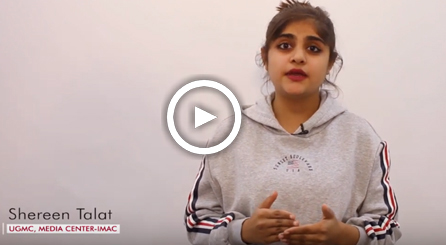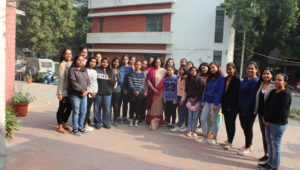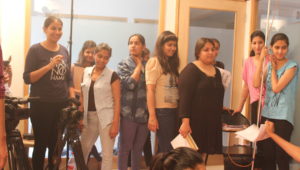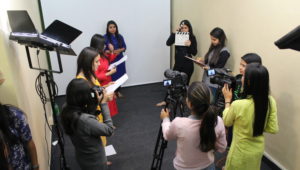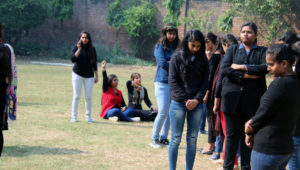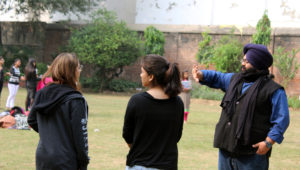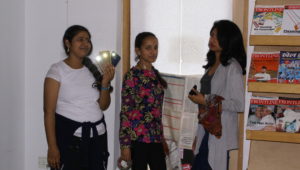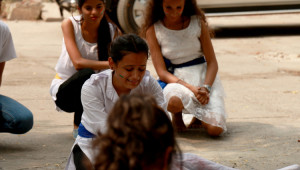Major practice in bulletin preparation
Television bulletins are usually made up from three elements:
- Written stories in the form of a script
- Visuals
- Voice reports from journalists, either recorded or live;
- The further element could be Motion Graphics.
Each of these criteria will help you to decide what stories you should include in your bulletin and where you should place them within your five, 10 or 15 minutes. It is usual to give the most important story first and the least important story last. If you are putting together your first bulletin, stick to this technique. The two main factors you have to consider are the overall order or balance of the bulletin and the pace of it.

SONY DSC
Keep Balance
Try to avoid seeing the bulletin simply as a collection of individual, self-contained stories. If you put a string of economic stories at the start of the bulletin, you risk losing your listeners’ interest. They expect a balance of items, some heavy and some light, some about major political events and some about ordinary people. Of course, the actual mix of stories, their tone and pace of delivery will depend to a degree on the format of your channel; serious national broadcasters tend to use more serious stories, delivered in a more deliberate style whereas youth-oriented bulletins might be lighter and brighter with more stories about popular culture. Your ranking of stories in order in the bulletin will give your audience some indication of how important you consider each story. But there is some freedom within bulletins to re-order stories to add variety and balance to the bulletin as a whole.
Decide the Pace
You must also get the right pace of stories through your bulletin. By pace we mean the length and tone of a story as it appears to the audience. Some stories have a fast pace. The report of a fire, for example, will usually be written in short sentences, using short snappy words to convey simple ideas. By comparison, a story explaining some involved political controversy may need slightly longer sentences with words expressing more complicated ideas. The story itself may need to be slightly longer. The whole effect is one of a slower pace. Too many long complicated stories will slow the pace of the whole bulletin and allow the attention of your audiences to wander. Too many short, sharp stories may leave audiences confused, unable to keep up with the pace of changing stories. Your ideal bulletin will have a steady pace throughout to maintain interest, with variations in pace during certain sections.
How to structure the bulletin
Bulletins are the broadcasting equivalent of a page on a newspaper, except that in radio and television you are more limited in where you place the different parts because, as we know, news bulletins are linear, therefore all the elements must be placed along the line of time so they are used most effectively.
How to start the bulletin
The foremost importance is given to first part of any news bulletin.
If you are faced with a choice between two stories of equal strength for your bulletin lead, choose the story which is more dramatic. If your obvious lead story is rather dull, you should write it in such a way as to add life. Keep the sentences short, the ideas clear and simple. Although you should try to write every story well, special attention should be given to your leading story. This is the one by which audiences will judge the bulletin.
Headlines
Once you have decided on the order of stories, you should write some headlines for the bulletin. It is usual to start a long bulletin by headlining the major stories. Your audiences will use the headlines to judge whether or not the bulletin is worth watching to, so write your headlines to promote the stories in the most powerful way possible.
It is good practice to headline the first two or three most important stories, and also one or two dramatic stories which come later in the bulletin. You should write headlines for dramatic stories in such a way that you hint at the drama without giving away all the details.
It’s a fact that in English bulletins, headlines do not have to be grammatically complete. They can be more like newspaper headlines, stripped down to the main words. The following are examples of possible headlines:
“More trouble for the Asian alliance.”
“Twelve die in a mine blast.”
“Why Russia is angry with Israel.”
What are closing stories?
Consider closing stories almost as important as lead stories. They are the last stories your audience will watch and remember from the bulletin. You need to choose them carefully.
Light or funny stories make the best tail-enders. They add relief and a change of pace to heavy bulletins. Also brings abundance of audience.
[This article is published by Media Center-IMAC in interest of student awareness and career guidance. Media Center-IMAC specializes in Post-Graduate/Under-Graduate diploma courses in Media Studies and Mass Communication & TV journalism. With practical oriented and industry specific course, Media Center- IMAC is a prominent institution in Delhi.
Our alumni have proven themselves in the media world and are currently working at prestigious media organizations and top news channels. Besides full time diploma courses, Media Center-IMAC also offers specialized certificate courses in TV reporting, Digital marketing, video editing, radio jockeying, photography and many more.
For more info, visit: http://www.mediacenterimac.com/
Or email at: mediacenterimac@gmail.com
Or call at: 011 43489010, 8076807939.]








